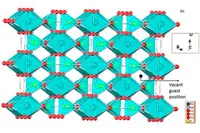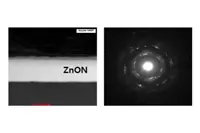Electronics News
Archive : 24 September 2015 год
 Through the development of its tru-FLEX semiconductor technology, SmartKem Ltd has signed Letters of Intent (LOI) with two Asian displays manufacturers. The agreements signify increasing interest for SmartKem’s semiconductors, with Asian manufacturers collaborating to drive manufacturing, integration and commercialisation of organic thin-film transistor (OTFT) technology in the flexible electronic display market.
Through the development of its tru-FLEX semiconductor technology, SmartKem Ltd has signed Letters of Intent (LOI) with two Asian displays manufacturers. The agreements signify increasing interest for SmartKem’s semiconductors, with Asian manufacturers collaborating to drive manufacturing, integration and commercialisation of organic thin-film transistor (OTFT) technology in the flexible electronic display market.
“This is a truly exciting time for SmartKem. The signing of these LOIs in Asia will allow SmartKem to gain significant traction for the tru-FLEX platform in one of our key geographies, and a global hub of the electronics sector,” commented Steve Kelly, founder and CEO of SmartKem.
These LOIs will allow SmartKem to implement and industrialise tru-FLEX into the production lines of leading display manufacturers, replacing like-for-like traditional competitive technologies such as amorphous silicon. Furthermore tru-FLEX technology can be processed at room temperature, without the need for cleanrooms and vacuum equipment, providing a clear path to low-cost display production.
Author
Tom Austin-Morgan
Source: www.newelectronics.co.uk
 A team of researchers in the Cockrell School of Engineering at The University of Texas, led by Professor John Goodenough, the inventor of the Lithium-ion battery, has identified a safe, nontoxic, inexpensive and sustainable cathode material for low-cost Sodium-ion batteries, called Eldfellite.
A team of researchers in the Cockrell School of Engineering at The University of Texas, led by Professor John Goodenough, the inventor of the Lithium-ion battery, has identified a safe, nontoxic, inexpensive and sustainable cathode material for low-cost Sodium-ion batteries, called Eldfellite.
Sodium-ion batteries are emerging as a promising rechargeable battery type and an alternative to Lithium-ion batteries because Sodium is abundant and inexpensive. In contrast, Lithium-ion batteries are limited by high production costs and availability of Lithium.
"At the core of this discovery is a basic structure for the material that we hope will encourage researchers to come up with better materials for the further development of Sodium-ion batteries," said Preetam Singh, a postdoctoral fellow and researcher in Goodenough's lab.
Although Sodium-ion batteries have potential, there are obstacles to advancing the technology including issues related to performance, weight and instability of materials. The team’s proposed cathode material addresses instability. Its structure consists of fixed Sodium and Iron layers that allow for Sodium to be inserted and removed while retaining the integrity of the structure.
One challenge the team is currently working through is that their cathode would result in a battery that is less energy dense than today's Lithium-ion batteries, achieving a specific capacity two-thirds of that of a Lithium-ion battery.
“There are many more possibilities for this material, and we plan to continue our research,” Singh said. "We believe our cathode material provides a good baseline structure for the development of new materials that could eventually make the Sodium-ion battery a commercial reality."
Author
Tom Austin-Morgan
Source: www.newelectronics.co.uk
 The sixth-generation of the iWRAP Bluetooth software stack has been released by Bluegiga for the Bluetooth 3.0 wireless audio accessory market. iWRAP 6.1 software is an embedded Bluetooth stack designed to support the WT32i Bluetooth Audio module. Target applications include smart phone accessories, stereo and hands-free audio, cable replacement and Bluetooth HID.
The sixth-generation of the iWRAP Bluetooth software stack has been released by Bluegiga for the Bluetooth 3.0 wireless audio accessory market. iWRAP 6.1 software is an embedded Bluetooth stack designed to support the WT32i Bluetooth Audio module. Target applications include smart phone accessories, stereo and hands-free audio, cable replacement and Bluetooth HID.
The iWRAP software stack is claimed to feature a powerful yet easy-to-use command interface enabling developers to manage Bluetooth operations. iWRAP software hides the complexity of the Bluetooth protocol stack and profiles for a range of applications, from simple audio applications to more complex use cases requiring interaction with several Bluetooth-enabled devices, or for multi-profile environments with simultaneous audio and data connections.
“The growing popularity of wireless audio streaming from mobile handsets continues to drive strong demand for Bluetooth classic audio solutions,” said Riku Mettälä, general manager of wireless module products at Silicon Labs. “We have continued to enhance our iWRAP stack to support the latest Bluetooth audio features while simplifying wireless development.”
iWRAP is supported by Silicon Labs’ BGScript scripting language, which is said to eliminate the added cost and complexity of using an external host MCU and separate software development kit required by conventional Bluetooth development alternatives.
No Bluetooth wireless development skills or tools are needed to use the iWRAP stack. The software’s ASCII-based command and response application programming interface over UART is said to simplify and accelerate Bluetooth application development.
iWRAP supports up to seven simultaneous connections with data throughput up to 500kbit/s, as well as 13 integrated profiles for data and audio applications including the Apple iAP1 and iAP2 profiles.
Author
Tom Austin-Morgan
Source: www.newelectronics.co.uk
 Researchers at Korea University and the Samsung Advanced Institute of Technology have developed a thin-film transistor that is said to be significantly faster than its predecessors. This is a step toward accelerating image displays on devices like TVs and smartphone screens.
Researchers at Korea University and the Samsung Advanced Institute of Technology have developed a thin-film transistor that is said to be significantly faster than its predecessors. This is a step toward accelerating image displays on devices like TVs and smartphone screens.
Much of the thin-film research involving zinc oxide materials has focused on the addition of metal cations, such as indium with gallium, hafnium, zirconium and lanthanide. When used in semiconductors, these exhibit mobility values from 5 to 20cm2/Vs.
"For future electronic devices, the mobility of the active oxide channel materials needs to be above 100cm2/Vs," said Sanghun Jeon, associate professor in the Department of Applied Physics and Department of Display and Semiconductor Physics at Korea University.
Jeon's group and their colleagues in the Analytical Engineering Group at the Samsung Advanced Institute of Technology built a zinc oxynitride (ZnON) transistor with electron mobilities about ten times greater than their previous thin-film transistors. They made the transistor from ZnON, which is plasma treated with argon gas.
Active oxide semiconductors, such as ZnON, provide a variety of benefits, such as a low cost of production and a relatively low temperature of fabrication: below 300°C. Making them suitable for display applications and making them easy to integrate with a variety of other inorganic and organic materials.
When subjected to conductance tests, the semiconductor speed, of the group’s thin-film transistor was found to be 138cm2/Vs, much higher than that of the group's previous indium-gallium-zinc-oxide film.
"We believe that ZnON, tailored by reactive sputtering and plasma processes, will constitute another significant breakthrough in the field of thin-film electronics," Jeon added.
Author
Tom Austin-Morgan
Source: www.newelectronics.co.uk
 Research by a team of scientists from England and Germany has developed techniques that it says will lead to the first memory chip that can capture light. This will allow large quantities of data to be stored directly on an integrated optical chip, rather than being processed and stored electronically, as happens today.
Research by a team of scientists from England and Germany has developed techniques that it says will lead to the first memory chip that can capture light. This will allow large quantities of data to be stored directly on an integrated optical chip, rather than being processed and stored electronically, as happens today.
Light is suited to ultra-fast high-bandwidth data transfer. Optical communications form an indispensable part of the IT world of today and tomorrow. However, a stumbling block so far has been the storage of large quantities of data directly on integrated chips in the optical domain.
Professor David Wright, from the University of Exeter's Engineering department said: "With our prototype we have, for the first time, a nanoscale integrated optical memory that could open up the route towards ultra-fast data processing and storage. Our technology might also eventually be used to reproduce in computers the neural-type processing that is carried out by the human brain."
While optical fibre cables have become part of our everyday life, data on a computer is still processed and stored electronically. The researchers have successfully captured light on an integrated chip, thus developing the first permanent, all-optical on-chip memory.
Oxford University’s Professor Harish Bhaskaran, one of the lead co-authors, said: "The written state is preserved when the power is removed, unlike most current on-chip memories."
"Optical bits can be written in our system at frequencies of up to 1GHz or more, and our approach can define a new speed limit for future processors, by delivering extremely fast on-chip optical data storage" added Prof Bhaskaran.
Author
Tom Austin-Morgan
Source: www.newelectronics.co.uk

